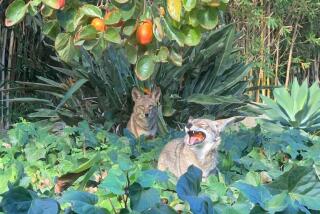For One Family, It’s a Feather in Their Cap
- Share via
The noises emitted from Pepe Sanchez’s ranch high up in the Santa Monica Mountains can be terrifying.
Hearing awful screeches, people new to the neighborhood or who happen to be passing by on steep, winding Yerba Buena Road come rushing up his dirt driveway, ready to rescue someone in dire need.
“They say, ‘Is somebody hollering for help?’ ” Sanchez said.
No help needed.
The source of the shrieks is Sanchez’s flock of pet peacocks, who sound an alarm whenever they are startled.
“They see something that’s not quite normal, they holler,” Sanchez said. “Like watchdogs.”
Nobody in the Sanchez family quite remembers when they got their first few peacocks, but they guess it was almost 20 years ago.
Even though the birds are not exactly loving creatures--they have absolutely no interest in receiving pats from human beings--there is a bond between the Sanchez family and the iridescent blue and green birds.
Most kids have lemonade stands; the Sanchez children set up peacock feather stands on the mountainous road 12 miles outside Thousand Oaks.
“They seem to be very much a part of us” Sanchez said, watching fondly as the flock pecked at the ground near him. “They love to be around us.”
Despite their longevity--Sanchez says he still has one of the original birds--the peacocks are relative newcomers to the ranch.
Sanchez and his father bought the land in 1951, 160 acres for a mere $7,500. Some of the land has been sold off since then, but Sanchez still has about 80 acres of scenic land just below Boney Mountain. He hopes his children will be able to hold on to the property for future generations.
Sanchez, 70, arrived from Mexico in 1925 at age 6 months with his parents. He grew as a cowboy, but as roundups and rodeos faded from the landscape, he opened a grading and earth-moving business.
A tribute to the way he makes his living lines his property line on Yerba Buena--a collection of ancient tractors and bulldozers forms a rusty silhouette against the hillside.
A sign arching above the driveway announces that a visitor has arrived at Peacock Paradise. But paradise is not so paradisiacal for the fowl. Though they have the run of the place, the coyotes and bobcats that roam the steep, rocky terrain near Sanchez’s ranch have discovered just how tasty a big, fat peacock can be. The flock’s numbers have been radically reduced over the years from 40 to little more than a dozen.
The birds just keep disappearing, leaving behind a disappointed Sanchez and a few brilliantly colored mementos.
“Just the feathers,” he said sadly. “We can follow the feather trail.”
The coyotes are partial to the pregnant peahens, who like to disappear into the brush to lay their eggs. So Sanchez and the rest of the family have taken to following the peahens, scooping them and the eggs up and keeping them in a pen.
This summer, two young peacocks or peahens--it’s impossible to tell the sex until males get older and develop their brilliant tails--pace the inside of the cage. Their mother hops on and off the roof of a little house Sanchez has built for the birds inside the pen. Impatient to get out and roam with the other birds, she does not seem to appreciate the coyote protection.
Up close, the birds are far more substantial than one would think. When they land, it is with a serious thud. Their flight is mostly limited to getting to higher ground, such as the upper branches of a tree or the roof of Sanchez’s house. Every morning they announce their awakening by clumsily thumping across the roof.
“Whenever we have someone new staying at the house they wake up all worried about what’s happening on the roof,” said Tesi Sanchez-Sims, one of Pepe’s five children.
More to Read
Sign up for The Wild
We’ll help you find the best places to hike, bike and run, as well as the perfect silent spots for meditation and yoga.
You may occasionally receive promotional content from the Los Angeles Times.






